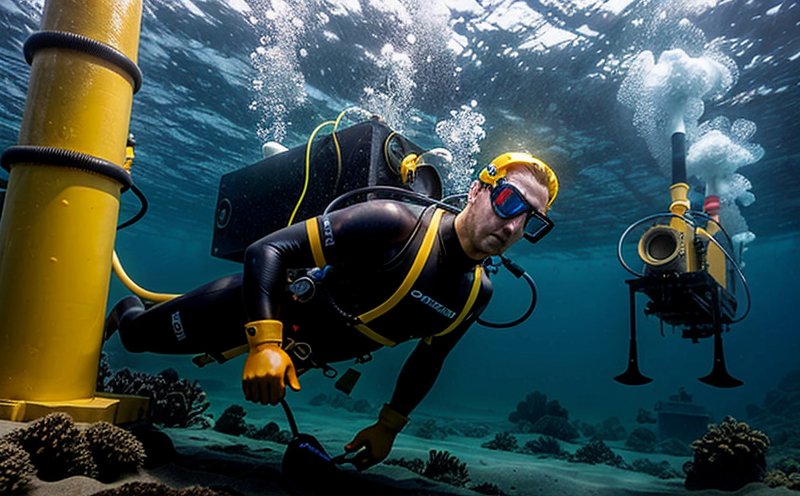ISO 16828 TOFD Ultrasonic Testing of Underwater Welds
The International Organization for Standardization (ISO) has established ISO 16828, a standard that provides the procedures and acceptance criteria for ultrasonic testing using Time-of-Flight Diffraction (TOFD) technology to assess the integrity of underwater welds. This method is particularly useful in the marine industry where weld quality can significantly impact safety, compliance, and operational efficiency.
Underwater welding poses unique challenges due to the environment; it demands a robust methodology that ensures accurate inspection without compromising the structural integrity or performance requirements of the welded components. TOFD ultrasonic testing addresses these challenges by providing high-resolution images of defects within the weld seam and surrounding metal structures, enabling precise assessment.
The primary advantage of ISO 16828 TOFD testing lies in its ability to detect even small flaws that might be missed by other inspection methods. This is crucial for ensuring the quality and reliability of underwater structures such as oilrigs, offshore platforms, subsea pipelines, and ship hulls. The standard's non-destructive nature also allows for repeated inspections during manufacturing or maintenance phases.
Compliance with ISO 16828 ensures that the testing process adheres to globally recognized standards, enhancing credibility in international markets where regulatory requirements are stringent. For quality managers and compliance officers, this service guarantees adherence to industry best practices, reducing risks associated with substandard welds that could lead to catastrophic failures.
R&D engineers can leverage TOFD technology for developmental testing, optimizing welding processes and materials to meet stringent performance benchmarks. Procurement professionals benefit from this service by ensuring the reliability of suppliers who adhere to international standards, thereby safeguarding critical infrastructure against potential hazards.
The process typically involves preparing specimens according to specific requirements detailed in ISO 16828, positioning probes correctly for TOFD imaging, and interpreting results based on established acceptance limits. Real-world applications include verifying weld integrity during construction phases of offshore facilities and ensuring the longevity of aging subsea assets through periodic inspections.
Benefits
- Enhanced Safety: Detects minute flaws that could lead to catastrophic failures, improving overall safety in marine environments.
- Comprehensive Inspections: Provides detailed images of weld defects without the need for dismantling or altering the structure.
- Cost Efficiency: Minimizes downtime and reduces costs associated with rework on defective welds by identifying issues early.
- International Recognition: Adherence to ISO standards ensures compliance with global regulatory requirements, expanding market reach.
The TOFD ultrasonic testing method is essential for maintaining high standards of quality in marine and ship equipment manufacturing. By leveraging this technology, organizations can achieve superior weld integrity while complying with international regulations.
Quality and Reliability Assurance
- Non-Destructive: TOFD testing does not damage the material being inspected, allowing for repeated inspections if necessary.
- High Resolution Imaging: Provides clear images of internal defects within welds, facilitating accurate assessment.
- Automated Interpretation: Advanced software tools help in interpreting data accurately, reducing human error.
The quality and reliability assurance measures associated with ISO 16828 TOFD testing are crucial for maintaining the integrity of marine structures. By adhering to these stringent standards, organizations can ensure that their welds meet or exceed industry benchmarks, thereby enhancing safety and operational efficiency.
| Parameter | Description |
|---|---|
| TOFD Imaging Resolution | Details the clarity of images obtained from TOFD testing. |
| Acceptance Limits | The permissible range for defects within welds to be considered acceptable. |
| Repeatability | The consistency of results across multiple tests on the same specimen. |
These parameters are critical in ensuring that the testing process adheres to ISO 16828 requirements, thereby guaranteeing the reliability and quality of the inspection.
Use Cases and Application Examples
| Use Case | Description |
|---|---|
| Offshore Oilrig Construction | Ensuring the integrity of critical welds during the initial construction phase. |
| Aging Subsea Pipelines | Monitoring for potential defects in pipelines to prevent leaks and failures. |
| New Ship Hull Manufacturing | Evaluating the quality of newly manufactured hulls before deployment. |
| Rehabilitation Projects | Checking weld integrity after maintenance or repair operations on marine structures. |
In each of these scenarios, ISO 16828 TOFD ultrasonic testing plays a pivotal role in ensuring that critical components meet the highest standards of quality and reliability. This method is indispensable for maintaining safety and operational efficiency in the marine industry.





